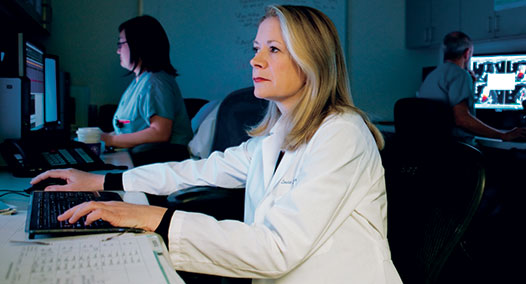Cardiac Imaging’s Bold New Leap

The heart’s tiniest vessels may yield some of the biggest clues to women’s heart disease. Cutting-edge cardiac imaging techniques that can reveal how the vessels behave could be a game changer in treating coronary microvascular disease (MVD), a condition more likely to affect women.
“There has been a huge leap in the last five years with advances in the technology we have to observe the heart,” says Louise Thomson, MBChB, an attending staff physician in Nuclear Medicine and Cardiac Imaging at the S. Mark Taper Foundation Imaging Center at Cedars-Sinai.
Dr. Thomson oversees a research core laboratory for studies at the Barbra Streisand Women’s Heart Center into the use of magnetic resonance imaging (MRI) stress tests in detecting and assessing MVD.
Women with MVD may not be diagnosed using standard tests for heart disease because such tests are better at looking for blockages in the large coronary arteries.
“We need to go further than those standard tests and quantify the flow of blood to the tiny vessels,” says Dr. Thomson. In particular, researchers are interested in measuring coronary flow reserve—the maximum increase in blood flow through the coronary arteries above the normal resting flow—in response to stress testing.
Cardiac MRI stress imaging is being performed as part of a sub-study of the Women’s Ischemic Syndrome Evaluation study launched by the National Institutes of Health 17 years ago, with C. Noel Bairey Merz, MD, director of the Barbra Streisand Women’s Heart Center, as principal investigator.
Using MRI as a diagnostic tool offers the advantage of no radiation exposure to patients. MRI cardiac stress testing is now available for clinical use to diagnose coronary artery disease and is proving helpful in diagnosing MVD. “The research has to be done to make sure this is a reliable way to test for this condition,” notes Dr. Thomson.
Dr. Thomson is part of a stellar team of cardiologists and scientists at Cedars-Sinai who are analyzing various imaging methods to diagnose and treat cardiovascular disease, with the goal of optimizing test accuracy and test selection.
Another top priority is refining imaging techniques to help doctors detect heart disease before plaque buildup can cause heart damage. “We’d like to intervene earlier with the appropriate lifestyle changes and risk management,” says Dr. Thomson.
The Barbra Streisand Women’s Heart Center is a leader in research in small vessel disease and women’s heart health, she notes. “Small vessel disease is a complex problem, and we are committed to improving existing techniques and finding the best test for each patient.”